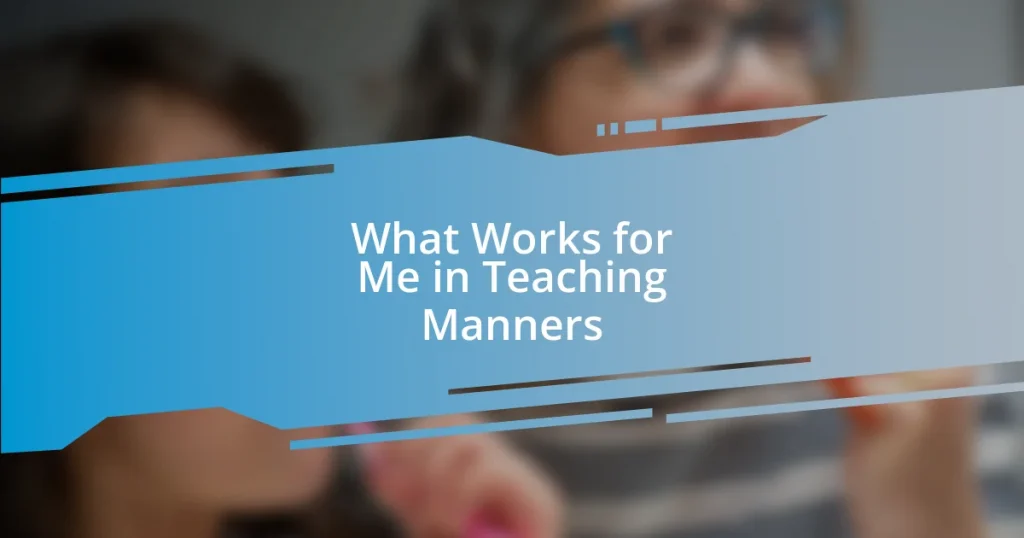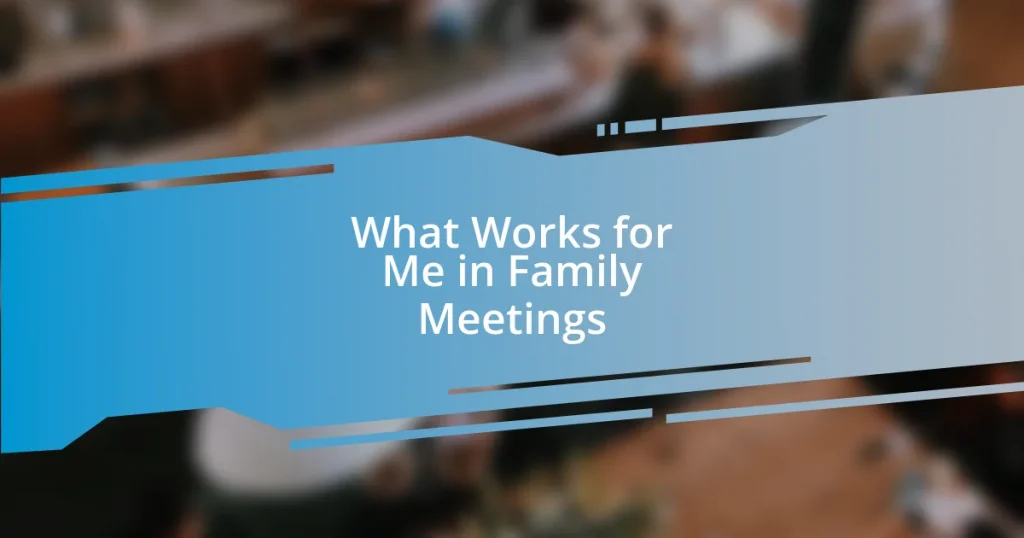Key takeaways:
- Manners are essential for fostering respect, empathy, and effective communication, benefiting both personal and professional interactions.
- Core manners to teach include saying “please” and “thank you,” practicing appropriate greetings, and using good table manners, which help develop social skills.
- Effective teaching strategies, such as storytelling, consistent reinforcement in real-life situations, and role play, engage children and make manners a natural part of their interactions.
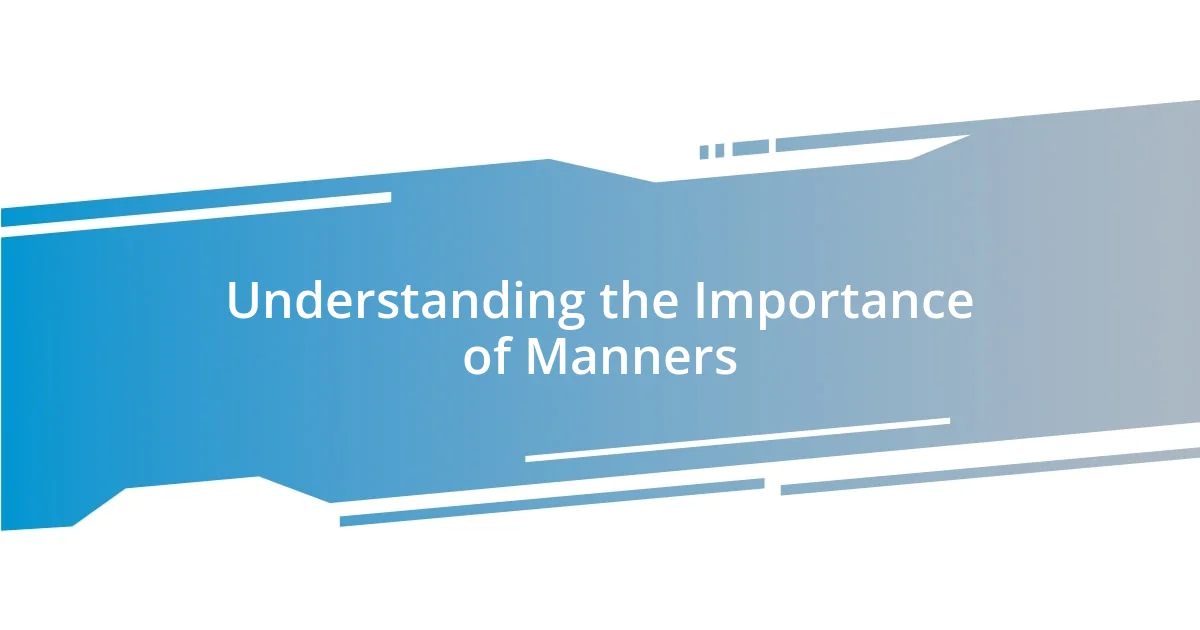
Understanding the Importance of Manners
Manners might seem like mere social niceties, but they are rooted in respect and empathy. I vividly remember being at a family gathering where my young niece, despite her shyness, said “please” and “thank you” without prompting. That simple act of kindness not only deepened our connection but also reminded me how those gestures create a warm atmosphere that invites positive interactions.
Have you noticed how a polite greeting can immediately brighten someone’s day? It’s a small but powerful act. When I worked with children, I often observed that teaching them to say “good morning” or “hello” fostered a sense of community and belonging. These everyday manners lay the groundwork for mutual respect, which is essential for effective communication.
Reflecting on my experiences, I believe that teaching manners equips children with social skills that are vital for their personal and professional lives. In my early teaching days, I saw students transform when I incorporated role-playing activities that emphasized polite phrases. The joy on their faces when they received praise for their efforts was a beautiful reminder of how manners not only enhance interactions but also boost self-esteem.
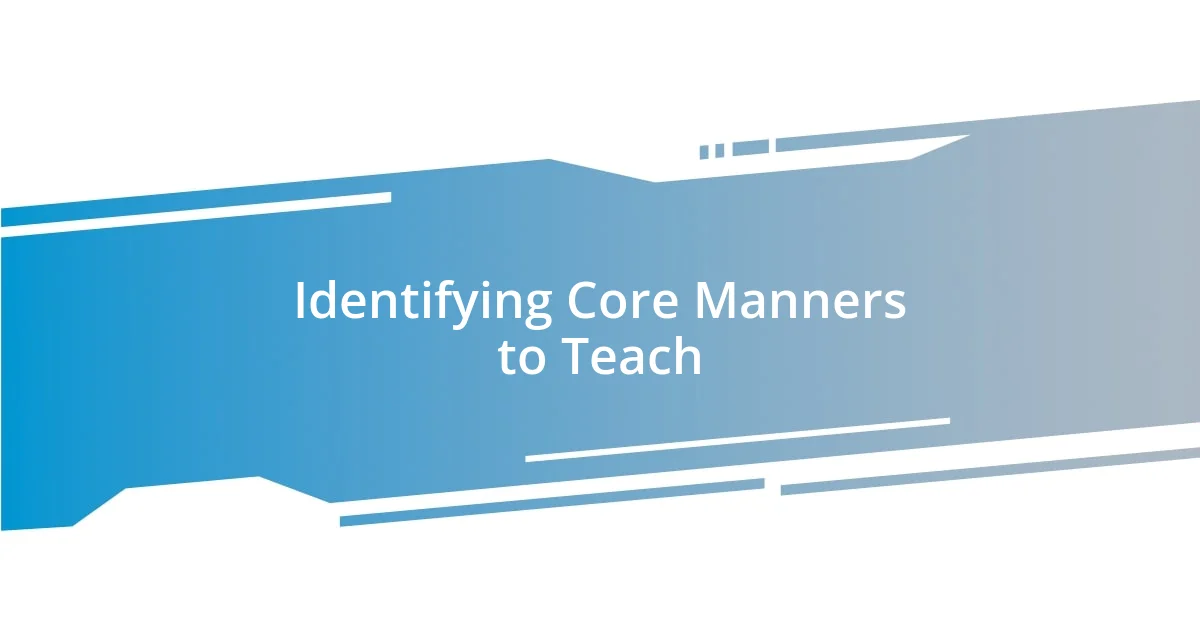
Identifying Core Manners to Teach
Identifying core manners to teach is essential because it sets the stage for respectful behavior in all social interactions. I’ve learned that it’s not just about what we teach, but how we model it. For instance, when I forgot to say “thank you” to a delivery person, my child immediately pointed it out. This reminded me that our actions speak volumes and that teaching manners often requires us to reflect on our own behaviors.
Here are some core manners that I think are essential for children to learn:
- Saying “please” and “thank you”
- Greeting others politely
- Using appropriate table manners
- Listening without interrupting
- Apologizing sincerely when needed
- Respecting personal space
Each of these manners builds a foundation for nurturing relationships and helps children feel more comfortable in social settings.
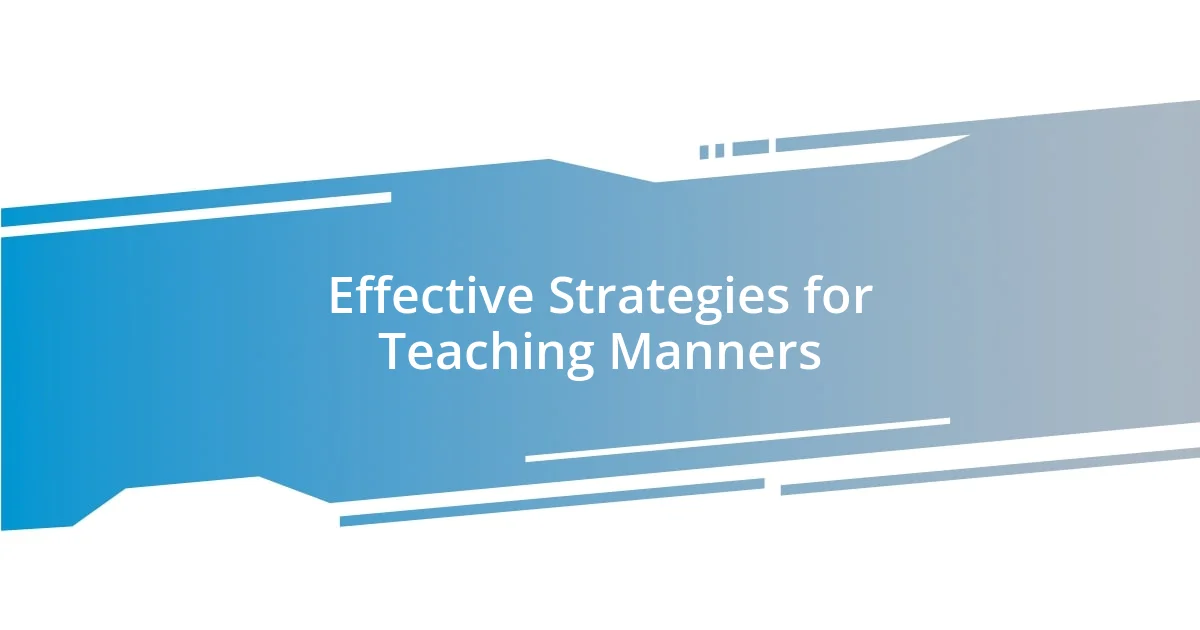
Effective Strategies for Teaching Manners
Teaching manners effectively often requires patience and creativity. I’ve found that using storytelling can be a powerful way to convey the importance of manners to children. For example, I once read a story about a little boy who learned how a simple “please” could turn a frown into a smile. Watching the children’s eyes light up as they understood the story’s message was incredibly rewarding. It’s amazing how narrative can engage young minds and make the lesson stick.
Consistent reinforcement is another key strategy that has worked wonders for me. When we attended a family dinner, I made an effort to remind my kids about table manners gently. It was like watching a light bulb go off in their heads when they remembered to chew with their mouths closed and pass food politely. These real-life situations reinforce the concept and provide ample opportunities for practice. Children often need reminders, but I’ve seen that those gentle nudges can lead to lasting changes.
Incorporating games into the learning process can make a significant difference too. I remember hosting a “Manners Bingo” night, where children got to mark off proper behaviors during conversations or meals. The excitement in the room was palpable, and they naturally began to implement those manners as they played. It turned learning into a fun experience, which is often the best way to teach.
| Strategy | Description |
|---|---|
| Storytelling | Engaging narratives to illustrate the importance of manners. |
| Consistent Reinforcement | Encouraging polite behavior in real-life situations. |
| Gamification | Using games to make learning about manners enjoyable and memorable. |
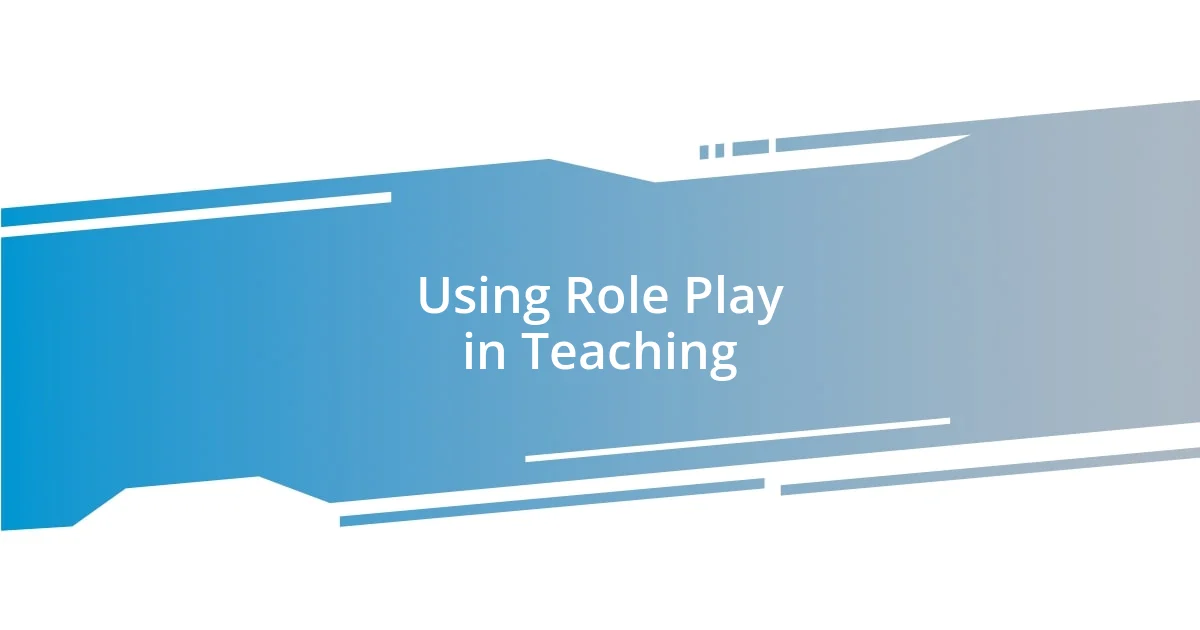
Using Role Play in Teaching
When I first introduced role play in teaching manners, I was surprised by how quickly my students got into character. One day, we acted out a scenario where one child was the customer and another played the cashier. The laughter that erupted when they exaggerated their roles made the lesson stick far better than I had anticipated. Isn’t it fascinating how kids can loosen up and embrace learning just by stepping into someone else’s shoes?
Role play not only engages children but also allows them to practice social skills in a safe environment. I remember a moment when one child, who typically struggled with initiating conversation, played a host at a pretend party. Watching him enthusiastically greet his guests, I realized how far he had come. It struck me that this kind of hands-on experience empowers them to navigate real-world interactions with confidence.
What I’ve learned is that role play fosters empathy and understanding among peers. Once, during a lesson about sharing, I had the kids take turns acting out scenarios that involved conflict resolution. The insights they shared afterward truly touched me. They didn’t just grasp the concept of sharing; they felt it. How could anyone argue against the effectiveness of teaching manners through the art of play? It’s a method that resonates deeply and cultivates genuine respect for others.
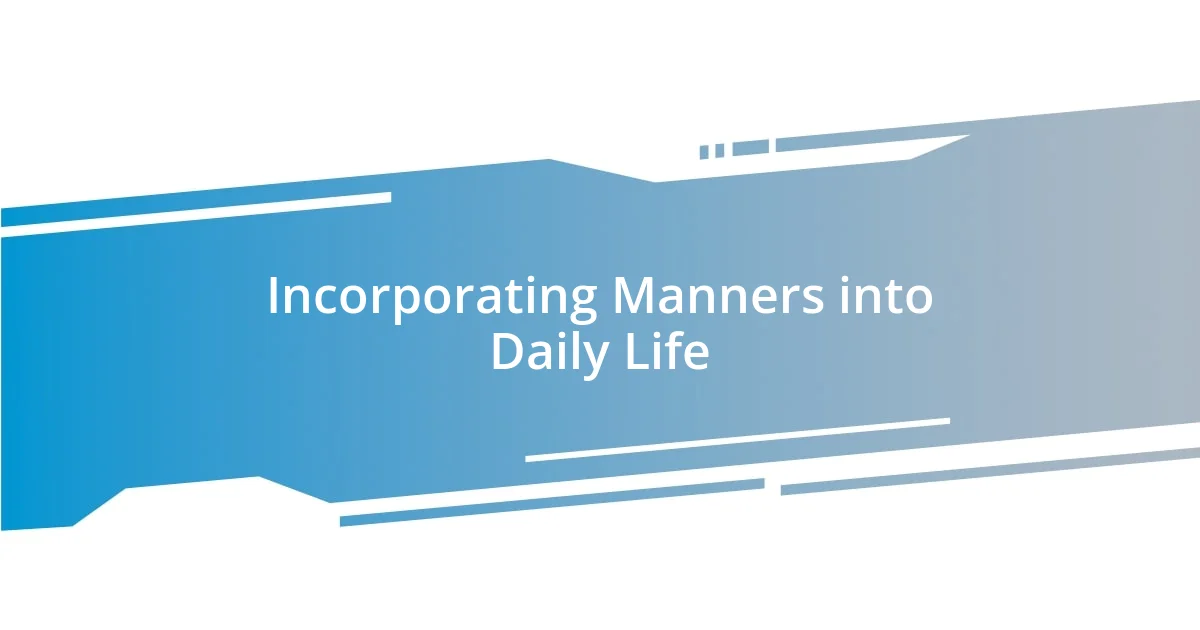
Incorporating Manners into Daily Life
Everyday moments can serve as perfect opportunities to weave manners into daily life. I recall a time I took my daughter grocery shopping. As we were checking out, I encouraged her to say “thank you” to the cashier. The smile on the cashier’s face lit up the whole experience. It made me realize that simple gestures can have such a profound impact on someone’s day. Why not utilize these routine activities to reinforce the importance of polite interactions?
Meal times are another brilliant setting to model and practice manners. I’ve made it a family tradition to share what we’re grateful for before each meal. Not only does this promote a sense of thankfulness, but it also opens up discussions about respect and kindness towards one another. It’s heartwarming to see my children not only express their gratitude but also consciously exhibit manners throughout the meal, like passing the salt politely or asking others if they’d like more. These small actions contribute to a bigger picture of caring relationships.
Even during playtime, manners can sneak into the fun. When my kids have their friends over, I encourage them to take turns choosing the next game or ensuring everyone is included. I often ask them, “How would you feel if someone didn’t let you play?” It helps them put themselves in another’s shoes. Watching them easily adopt these behaviors while laughing and enjoying each other’s company truly affirms that manners can become an effortless part of their daily interactions. How rewarding is it to see kindness manifest naturally in their friendships?
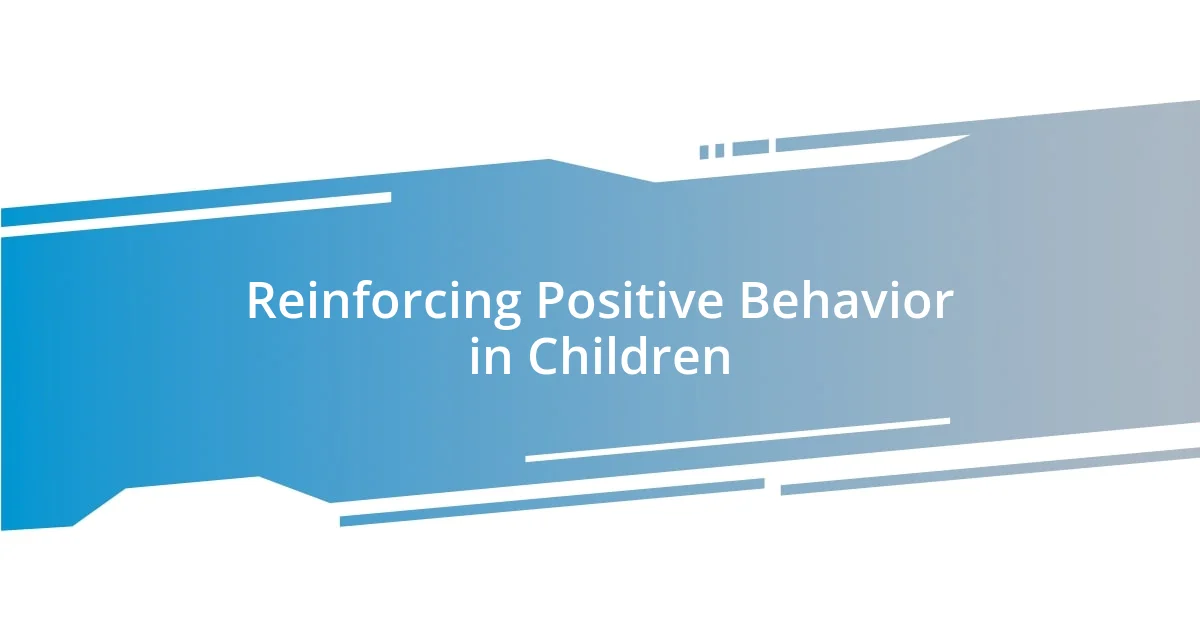
Reinforcing Positive Behavior in Children
Reinforcing positive behavior in children is a journey that requires consistency and creativity. I remember one particular evening when my son helped a neighbor carry in their groceries. Instead of simply acknowledging the kind act, I seized the moment to highlight his thoughtfulness. We talked about how helping others can brighten their day, and I could see the pride in his eyes. Isn’t it amazing how recognizing even small gestures can motivate kids to repeat those behaviors?
I’ve found that praise goes a long way in encouraging good manners and behavior. During a playdate, I caught my daughter politely asking her friend if they’d like to share a toy. In that moment, instead of a simple “good job,” I enthusiastically celebrated her kindness, saying, “Wow, that was so thoughtful! You made your friend feel special.” Her face lit up, and I was reminded how impactful genuine acknowledgment can be. When we highlight the positives, children learn to associate good behavior with joy and pride.
Modeling and discussing positive behavior in everyday situations is also key. I often initiate family discussions about moments of kindness we observe throughout the day. Just the other day, I asked my kids about an instance where they saw someone being considerate. They eagerly recalled seeing a stranger help another individual in a wheelchair. Engaging in these conversations not only reinforces what they learn but also helps them recognize and appreciate kindness in the world around them. How often do we take the time to notice and discuss these moments?
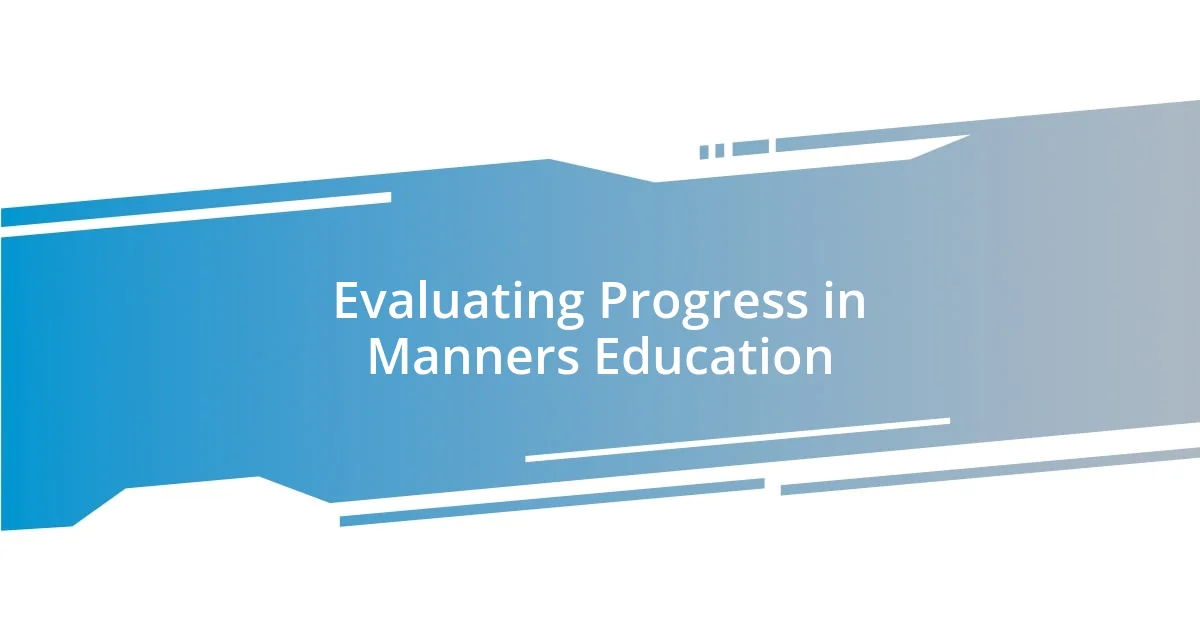
Evaluating Progress in Manners Education
Evaluating progress in manners education is like keeping a pulse on a child’s emotional development. I remember the first time my daughter spontaneously held the door for someone else. It was such a little action, yet it filled me with immense pride. As I observed her, I thought: “This is what we’ve been working toward.” Tracking these small, delightful moments helps me gauge how deeply these manners are taking root.
Observation plays a crucial role in this evaluation process. I make it a point to pay attention during our family gatherings, where the kids interact with various relatives. I often jot down notes about their behavior, like how they offer help to older family members or engage in polite conversation. Seeing them exhibit these manners in multiple settings reassures me that they are learning to navigate social interactions with kindness and respect. Reflecting on these instances, I ask myself how these behaviors enhance our family dynamics.
Feedback is another essential component. I believe in discussing my observations with my children afterward. For instance, after a birthday party, we sat down to talk about the day. I asked them how they felt when they thanked their friends for coming. They shared that it felt good and made others happy too. This dialogue not only reinforces their good behaviors but also helps me understand their perspectives on manners. It’s an enlightening experience—what other teachable moments might we miss if we don’t take the time to reflect on their feelings?











